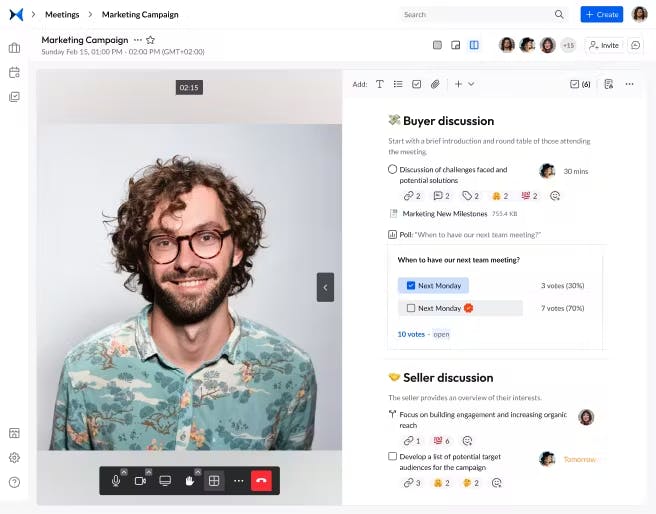January 22, 2024 · 9 min read
How to Conduct Vote of No Confidence in Board Meetings

Shaimaa Badawi

"Vote of no confidence" – a phrase with the power to significantly alter the course of corporate leadership. This term represents more than just a procedural step; it's a pivotal moment that can redefine an organization's future.
In this article, we explore how this influential proceeding reshapes the dynamics of corporate governance and which modern-day tool can empower the way these decisive votes are handled.
What does no-confidence mean in a meeting?
A vote of no confidence in the context of board meetings is a pivotal measure, reflecting the board's collective unease or disapproval towards a leader's performance or decision-making.
This significant move, typically reserved for situations where a leader's actions are deemed harmful or misaligned with the organization's principles, is not about minor disagreements. Instead, it arises from serious concerns about leadership that might include unethical behavior, strategic missteps, or a breach of the company's core values.
While it doesn't automatically result in dismissal, it marks a clear signal that the leader's approach or conduct needs urgent reassessment, echoing the board's duty to uphold the organization's integrity and direction.
What is the significance of a vote of no confidence in a meeting?
In boardroom dynamics, a vote or motion of no confidence acts as a critical indicator of the board's deep concerns or dissatisfaction with its leadership. This vote serves as a red flag, signaling serious issues at the organization's management, often related to leadership actions or decisions that are potentially damaging to the company's course.
Why is a vote of no confidence raised?
A vote of no confidence is raised not over trivial disagreements or strategic differences, but for serious matters. These can include unethical behavior, lack of responsibility, or decisions that severely contrast with the organization's core values and mission. It reflects a significant rift between the board's expectations and the leader's actions.
How does a vote of no confidence reflect on the board's selection process?
This vote is a crucial part of the board's responsibility and reflects on their selection process. Board members typically seek leaders with integrity, effective communication skills, and an ability to inspire. A vote of no confidence often follows a realization that these expectations are not being met, especially in a manner that adversely affects the organization.
What are the consequences of a vote of no confidence?
A vote of no confidence does not immediately lead to the removal of a leader. Instead, it serves as an indicator that the leader's actions are under serious scrutiny. It can be a wake-up call for self-reflection and possible redirection. In some cases, it might lead to removal, but it is not always the immediate outcome.
How does a vote of no confidence uphold organizational integrity?
Such a vote is testament to the essential checks and balances in any organization. It allows the board to formally express its concerns and maintain the integrity and direction of the company. It ensures that the organization remains true to its mission and values, signifying the board's commitment to responsible board governance.
Master the art of board meetings—download your free guide, "Navigating the Boardroom: A Practical Guide to Effective Board Meetings," today!
What should you consider before a no-confidence vote?
Before a board member takes the significant step of calling for a vote of no confidence, it's crucial to deliberate carefully. This decision should not be made lightly, as it can have far-reaching implications. Here are some key questions that a board member should consider:
1. Objective assessment
What are you aiming to achieve with this vote? It's important to have a clear understanding of the desired outcome and the specific actions you anticipate following the vote. How will you measure the success of these actions?
2. Potential impact and consequences
Have you considered the potential outcomes, both immediate and long-term, of such a vote? It's vital to weigh the benefits and drawbacks, thinking about how different stakeholders, including staff, the community, and other board members, might react.
3. Severity of the issues
Are the concerns serious enough to warrant this step? Reflect on whether all other possible solutions have been explored and exhausted. Remember, a vote of no confidence is generally seen as a measure of last resort.
4. Broad consultation
Have you discussed the issues thoroughly with others? It's advisable to discuss your concerns with the entire board and other relevant parties. Understanding different perspectives and opposition views is critical for a balanced approach.
5. Professionalism in discussions
Are the discussions and considerations centered around professional conduct and performance, rather than personal biases or opinions?
6. Action plan post-vote
What steps will be taken after the vote, regardless of the outcome? It's important to have a plan for the subsequent months to ensure the organization remains stable and focused on its goals.
What are the pros and cons of a no-confidence vote?
Pros
1. Elimination of problematic leadership
The primary advantage is the removal of an individual in a position of power if they are deemed harmful to the organization. This action can prevent further damage and is essential for the health of the organization.
2. Upholding democratic principles
Engaging in a vote of no confidence allows members to express their views and make crucial decisions collectively. This can foster a greater respect for the democratic system among all involved, reinforcing the value of collective decision-making.
Cons
1. Emotional and mental impact on the individual
The individual in question may feel targeted or attacked, which could manifest in a retaliatory response. Being removed from a position in such a manner can be long-lasting and potentially irreversible, tarnishing their professional reputation.
2. Consequences for the organization
The organization itself is not immune to fallout. Such a drastic action can raise doubts about the decision-making abilities of the board or other leaders involved. This could erode confidence internally and externally, affecting the organization’s stability and reputation.
3. Deterrent effect on potential leaders
This decision can also make the position less attractive to potential successors. Prospective leaders might be hesitant to step into a role where the previous occupant was forcibly ousted, perceiving an unstable or hostile environment.
Vote of no confidence in Robert's Rules of Order
Under Robert’s Rules, a vote of no confidence is not inherently a mechanism for removing someone from a position. Robert's Rules of Order, a widely recognized guide for conducting meetings and organizational procedures, does not specifically address the concept of a "vote of no confidence."
Organizations are, therefore, at liberty to interpret and apply the concept within their governance structures. Importantly, such a motion could stipulate that a successful vote of no confidence might necessitate the leader stepping down, but this is an addition made by the organization itself, not a standard rule within Robert's Rules.
How to call for a vote of no confidence in board meetings
In board meetings, the process of conducting a vote of no confidence is a structured and strategic approach. Here are the key steps involved:
Step 1: Seek resolution before escalation
Before proceeding with a vote of no confidence, it's essential to address the issue directly with the concerned leader. This step is crucial to determine if the problem is a fundamental concern for the company or merely a difference in perspectives among board members.
Step 2: Formally call for the vote
If resolving the issue is unsuccessful, any board member can initiate the process by formally proposing a vote of no confidence against the leader in question. This step should be considered only after all other avenues for resolution have been exhausted.
Step 3: Gather support through a petition
Prior to the vote, it’s important to determine the level of support for the motion. This can be achieved by circulating a petition among board members. If a no-confidence vote fails, it can have negative repercussions on the board’s image and the organization, so ensuring sufficient backup is a key preparatory step.
Step 4: Allow the leader to state their case
Before the vote takes place, the leader who is the subject of the vote should be given an opportunity to present their side of the story. This step is not only fair but also crucial, as it might influence the opinions of board members and the outcome of the vote.
Step 5: Conduct the vote
After ensuring adequate support and hearing the leader’s response, the board can proceed with a formal vote. This process should adhere to the company’s bylaws and ensure that the voting is conducted in a secure and confidential manner.
Step 6: Decide on follow-up actions
The outcome of the vote guides the next steps. A majority vote in favor does not automatically remove the leader from their position but can lead to further actions towards their dismissal. Conversely, a failed vote suggests the need for continued dialogue and possible adjustments rather than immediate removal.
Empower your board's decision-making with adam.ai
To navigate the intricate details of a no confidence vote in board meetings, it's vital to consider the tools that can facilitate such a complex process. This is where an all-in-one meeting management platform, like adam.ai, becomes instrumental.
Here's what you can do with adam.ai:
1. Sync all your calendars on one platform and create unlimited booking pages to show your availability to attendees for easy scheduling.

2. Record agenda items, actions, polls, decisions, and notes using a smart note-taking system displayed side by side with the built-in video-conferencing feature for enhanced collaboration and productivity, with the ability to integrate with popular video-conferencing tools you're familiar with.

3. Choose a customizable meeting agenda template from our gallery to kickstart preparation for your meetings for maximum productivity.

4. Track your actions to ensure task ownership and accountability and improve decision-making with a powerful follow-up system and the ability to search for actions across all meetings.

5. Categorize meetings into spaces, including project, team, board, and committee, and have all their content under a specific umbrella for easy access.

6. Generate and share meeting minutes for due diligence and to keep a record for future reference.

7. Ask Adam the AI Assistant to generate meeting transcripts, enhance your meeting content, suggest agendas, and highlight action items and key insights.

Get started right now to experience the true meaning of all-in-one meeting management.
Transform how you conduct critical meetings—From meticulous preparation to effective execution and insightful follow-up, adam.ai integrates comprehensive analytics, full customization, and intuitive interfaces with powerful meeting management tools.
Easy onboarding. Enterprise-grade security. 24/7 dedicated support.
The bottom line
To sum up, a vote of no confidence stands as a testament to the democratic principles within corporate governance, embodying a tool of transformative potential. Its significance extends far beyond mere procedure, representing a crucial juncture where the future of an organization can be reshaped.
We recommend using an all-in-one meeting management platform, like adam.ai, to empower your board's decision-making process and facilitate the process of conducting a vote of no confidence.
And while there may be multiple meeting management solutions available, here is why adam.ai is the all-in-one meeting management platform you can trust:
- adam.ai is one of Atlassian Ventures' portfolio companies.
- In the meeting management software category on G2, adam.ai has been ranked a leader and a high performer for successive quarters in the past years.
- adam.ai has been included in the Forrester Report in the AI-enabled meeting technology landscape.
- adam.ai is trusted and used by powerful teams and organizations worldwide for all types of critical meetings, like board, committee, project management, and business development meetings.
- And most importantly, adam.ai integrates with your existing workflow, is SOC2 compliant, provides dedicated support and success, and has a free trial option.
Subscribe to adam.ai blog
Stay ahead with the latest insights—get our newest blog posts, tips, and updates sent straight to your inbox.